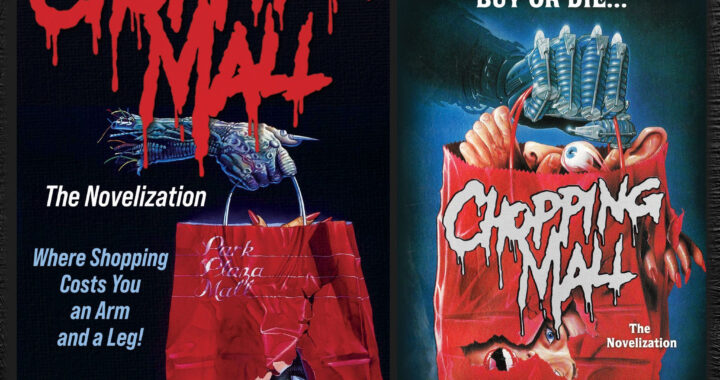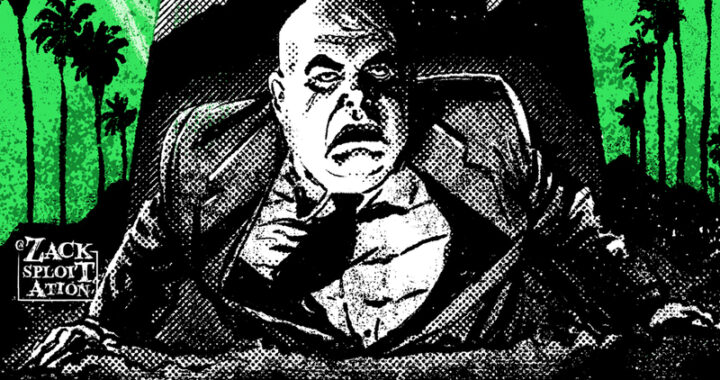
“THE MAN WHO WAS ALWAYS LATE“ WHAT THE FLASH TEACHES US ABOUT RELATIONSHIPS
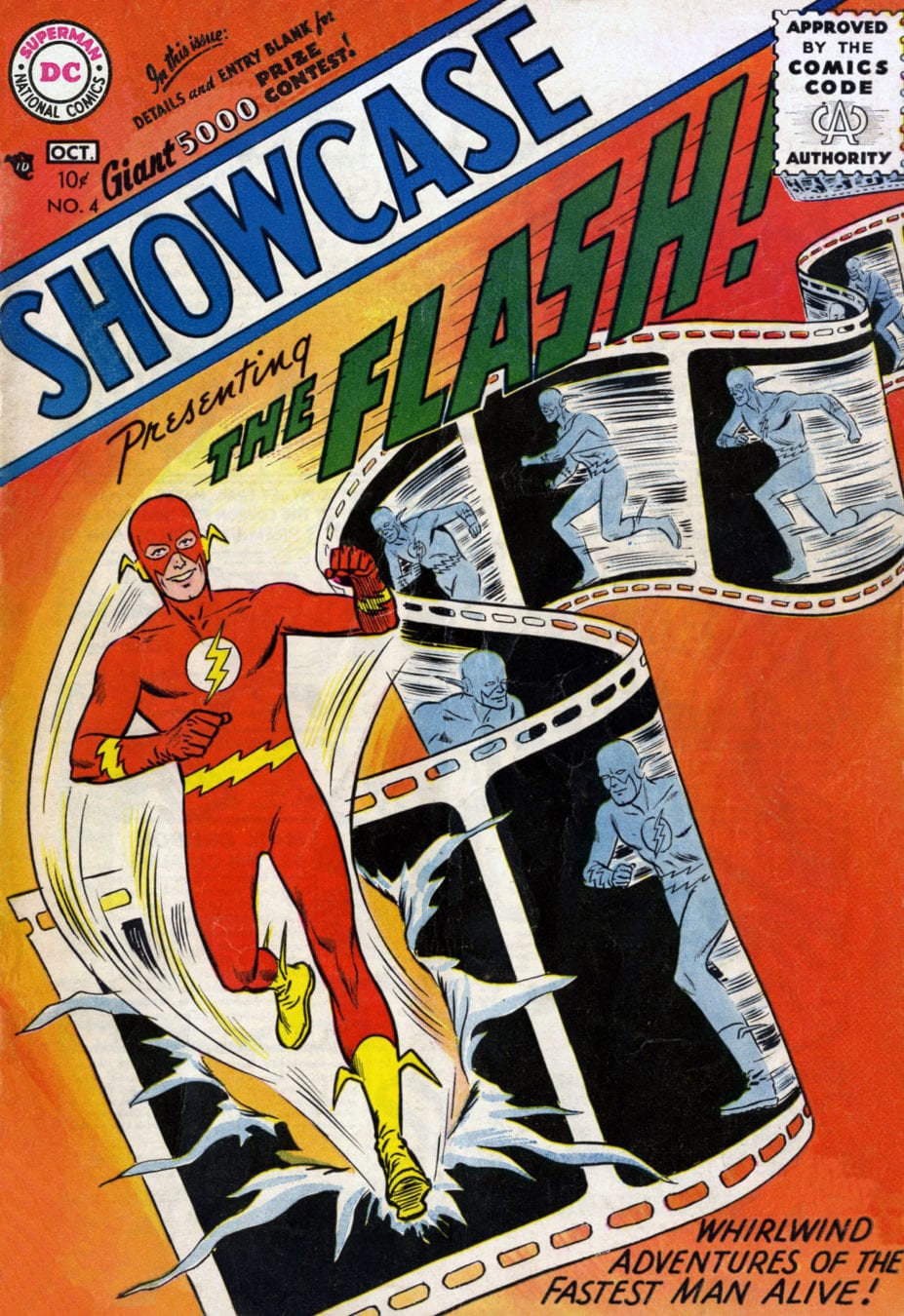 The joke with The Silver Age Flash was that he was always late. He was the Fastest Man Alive, the Scarlet Speedster, the Monarch of Motion. Yet in his civilian identity as police scientist, Barry Allen was always late. To every appointment. And he showed up late to every date with his fiancée Iris West. And Iris got angry. And she would admonish Barry. Every Time. Time had always played an important role in his life even before the accident which bestowed superspeed upon him and thus turning him into a man not only capable of breaking the sound barrier, but the barrier of time itself. Yet with the same ease with which only the Sultan of Speed would be able perform these mercurial feats, he broke his commitments with his fiancée. It mattered. Every time. Even long before Barry became the superfast superhero of his hometown Central City, like clockwork, he would show up late for his dates with Iris. This was the point of contention between the couple for the entire time of their courtship. And even after, once the two got married to each other. This conflict, Barry“s constant lateness and Iris“ reaction to it, got set up right from the start, in Showcase No. 4 (1956), the famous issue by Robert Kanigher, Carmine Infantino and Joe Kubert that introduced us to The Silver Age Flash. This issue also introduced us to his date Iris, who we see in the second panel on page six. What defines Iris in the very first panel we the readers see her in, is her reaction to Barry“s action. Any identity and agency her character might have, is defined by how she relates to Barry“s behavior. When we meet Iris West for the first time, the first words she says are: “Barry”¦ you“re always late! Why are you so slow?”“ Police Scientist Barry Allen“s answer sounds like one of many lame excuses a guy like him would be making up all the time, because he was late all the time: “Sorry Iris! I was checking some new chemicals that just came in and”¦”“ Because Barry was late this time again. His mind had neither been on Iris or on the time they had set to meet. But he was not too late. Having received his superpowers during the previous evening when in a freak accident a lightning storm exploded chemicals in his lab all over his body, his superfast eyes caught a stray bullet fired by a villain. Turtle Man, the criminal called “The Slowest Man on Earth!”“, making his escape from police. When later in the story, Barry in his identity as The Flash encounters this peculiar villain, he is never seen with any firearm, and this shot fired from which the bullet stems, is off panel. So we are left to wonder. But Barry sees the bullet. Up to this point in time, he isn“t even convinced that he has gained superpowers. Maybe it was a dream. Maybe there is a scientific explanation why he thinks that he might have. But when he sees the bullet, he knows. He has superpowers. He can see the bullet“s path is if it moved in slow motion. And it flies straight towards Iris“ head. He sees it. Nobody else does. His eyes are this quick. And so are his reflexes when he pushes Iris out of the bullet“s way. Iris is safe, and so is his secret, since Iris figures that he stumbled against her by accident “just before that stray bullet struck.”“ With the next panel we the readers are back at Barry“s lab where he contemplates that he is now “The Fastest Man on Earth!”“
The joke with The Silver Age Flash was that he was always late. He was the Fastest Man Alive, the Scarlet Speedster, the Monarch of Motion. Yet in his civilian identity as police scientist, Barry Allen was always late. To every appointment. And he showed up late to every date with his fiancée Iris West. And Iris got angry. And she would admonish Barry. Every Time. Time had always played an important role in his life even before the accident which bestowed superspeed upon him and thus turning him into a man not only capable of breaking the sound barrier, but the barrier of time itself. Yet with the same ease with which only the Sultan of Speed would be able perform these mercurial feats, he broke his commitments with his fiancée. It mattered. Every time. Even long before Barry became the superfast superhero of his hometown Central City, like clockwork, he would show up late for his dates with Iris. This was the point of contention between the couple for the entire time of their courtship. And even after, once the two got married to each other. This conflict, Barry“s constant lateness and Iris“ reaction to it, got set up right from the start, in Showcase No. 4 (1956), the famous issue by Robert Kanigher, Carmine Infantino and Joe Kubert that introduced us to The Silver Age Flash. This issue also introduced us to his date Iris, who we see in the second panel on page six. What defines Iris in the very first panel we the readers see her in, is her reaction to Barry“s action. Any identity and agency her character might have, is defined by how she relates to Barry“s behavior. When we meet Iris West for the first time, the first words she says are: “Barry”¦ you“re always late! Why are you so slow?”“ Police Scientist Barry Allen“s answer sounds like one of many lame excuses a guy like him would be making up all the time, because he was late all the time: “Sorry Iris! I was checking some new chemicals that just came in and”¦”“ Because Barry was late this time again. His mind had neither been on Iris or on the time they had set to meet. But he was not too late. Having received his superpowers during the previous evening when in a freak accident a lightning storm exploded chemicals in his lab all over his body, his superfast eyes caught a stray bullet fired by a villain. Turtle Man, the criminal called “The Slowest Man on Earth!”“, making his escape from police. When later in the story, Barry in his identity as The Flash encounters this peculiar villain, he is never seen with any firearm, and this shot fired from which the bullet stems, is off panel. So we are left to wonder. But Barry sees the bullet. Up to this point in time, he isn“t even convinced that he has gained superpowers. Maybe it was a dream. Maybe there is a scientific explanation why he thinks that he might have. But when he sees the bullet, he knows. He has superpowers. He can see the bullet“s path is if it moved in slow motion. And it flies straight towards Iris“ head. He sees it. Nobody else does. His eyes are this quick. And so are his reflexes when he pushes Iris out of the bullet“s way. Iris is safe, and so is his secret, since Iris figures that he stumbled against her by accident “just before that stray bullet struck.”“ With the next panel we the readers are back at Barry“s lab where he contemplates that he is now “The Fastest Man on Earth!”“
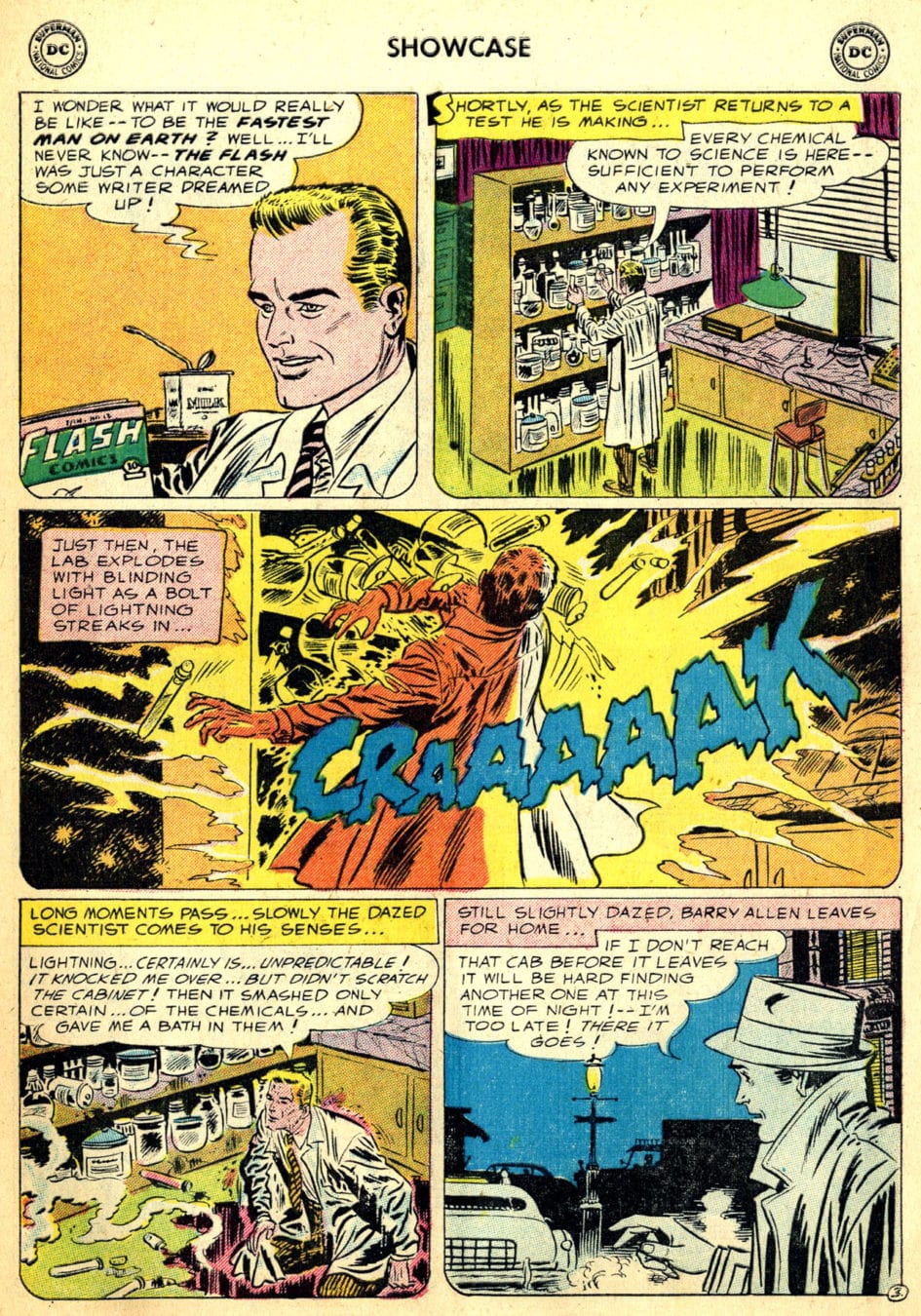 There would be no panel showing how Iris thanked Barry for saving her life. Or maybe taking the whole situation in. Instead we see Barry looking at a comic book (Flash Comics, its hero to be later folded into the reality of Barry“s world as a doppelganger from an alternative Earth), making the decision to use his newly acquired superpowers “to help humanity”“ (of course) by becoming a superhero. Iris is only seen again six pages later in the last panel of the story, remarking “how exciting it would be to a meet a man like that!”“, The Flash that is. And with the first story in this issue we are off to the races. A new superhero is born, the hero that would bring about the Silver Age of Superheroes, the rebirth of the superhero at DC / National Comics and at many other comic book publishers only a short time later. But we also get the beginning of a relationship between a hero and his female companion that is remembered fondly among many readers who were reading these books when they came out or at some later point in time. A relationship that would play out so very differently to how many readers remember it though, myself included. When I was a kid in the late 70s and early 80s, The Flash was my favorite superhero from DC. Sure, The Batman was all dark and mysterious, but to me as a kid, the appeal of The Flash was that here was a hero who was in an adult relationship. He was a middle-class working guy, not a millionaire who had a mansion and a skyscraper headquarter and a cave beneath both structures. But Barry was married to a wife who was his companion and his equal in many ways. They were a bit square like many couples I knew at that time observing the adults, but while Barry was a police scientist and a superhero, Iris was a reporter for a newspaper. She got in on the action, she was a homemaker and yet she made sure that when the occasion called for it, she and Barry looked their fashionable best. And they were devoted to each other. They truly trusted each other. But this was NOT how it was, was it? Going back through the history of The Flash, using the Cosmic Treadmill to traverse time as The Scarlet Speedster would many times, or simply by going back to the very first issue in 1956, and then going forward, a different story unfolds, and you will realize quickly that if you picked up reading The Flash with let“s say issue No. 242 (1976) and being able to go back only like fifteen back issues you could find at a store that sold comics, how I came to this series, you arrived at the mid-point of what is called a character arc. In this case the arc of characters, two in fact, a man and a woman, and their relationship with each other. But if you do go back to the beginning, there is a strong chance that you do wonder why it is they who have a date with each other in Showcase No. 4. We do not know how long they have been dating at this point, but right in that first issue and in the seven panels they share together, there is an uneasy feeling between them. There is an imbalance of power right from the start. Other than the full opening page to the story and two panels, Barry, either in his civilian identity or as The Flash, is in every panel. His date, Iris, has no panel to herself. We learn next to nothing about her other than that the first thing we see her do is to admonish our hero for being late. To the reader this must come across as a joke, a mean one at that, and at the expense of Iris, because we have already seen how fast Barry is. We know that Barry is our guy, that he is this new, superfast superhero in the sleek red uniform we see on the cover. The “always”“ in “always late”“ almost gets lost when Iris does not stop there, but turns her reprimand into an insult: “Why are you so slow?”“ But we the reader know that he isn“t slow. And his superfast eyes see the bullet. So we side with Barry. Even though Iris seemed to have a good enough reason to be annoyed with him. Even though we are just introduced to their relationship, we get that this was not the first or the second time Barry showed up late to one of their dates. We get that this happened “always”“, that Barry did not respect his commitment or her. Yet the way Iris is presented in both the writing and the art, in the very first panel she is in (with Barry), we also see her treat him like he is very much inferior to her. Theirs is not a healthy relationship that is built on warmth and encouragement. And then there was the closing panel to the story that gave us this new Flash and his world, and it showed us that Barry would not trust her with his identity as superhero. Instead he let her swoon over The Flash whom she wanted to meet.
There would be no panel showing how Iris thanked Barry for saving her life. Or maybe taking the whole situation in. Instead we see Barry looking at a comic book (Flash Comics, its hero to be later folded into the reality of Barry“s world as a doppelganger from an alternative Earth), making the decision to use his newly acquired superpowers “to help humanity”“ (of course) by becoming a superhero. Iris is only seen again six pages later in the last panel of the story, remarking “how exciting it would be to a meet a man like that!”“, The Flash that is. And with the first story in this issue we are off to the races. A new superhero is born, the hero that would bring about the Silver Age of Superheroes, the rebirth of the superhero at DC / National Comics and at many other comic book publishers only a short time later. But we also get the beginning of a relationship between a hero and his female companion that is remembered fondly among many readers who were reading these books when they came out or at some later point in time. A relationship that would play out so very differently to how many readers remember it though, myself included. When I was a kid in the late 70s and early 80s, The Flash was my favorite superhero from DC. Sure, The Batman was all dark and mysterious, but to me as a kid, the appeal of The Flash was that here was a hero who was in an adult relationship. He was a middle-class working guy, not a millionaire who had a mansion and a skyscraper headquarter and a cave beneath both structures. But Barry was married to a wife who was his companion and his equal in many ways. They were a bit square like many couples I knew at that time observing the adults, but while Barry was a police scientist and a superhero, Iris was a reporter for a newspaper. She got in on the action, she was a homemaker and yet she made sure that when the occasion called for it, she and Barry looked their fashionable best. And they were devoted to each other. They truly trusted each other. But this was NOT how it was, was it? Going back through the history of The Flash, using the Cosmic Treadmill to traverse time as The Scarlet Speedster would many times, or simply by going back to the very first issue in 1956, and then going forward, a different story unfolds, and you will realize quickly that if you picked up reading The Flash with let“s say issue No. 242 (1976) and being able to go back only like fifteen back issues you could find at a store that sold comics, how I came to this series, you arrived at the mid-point of what is called a character arc. In this case the arc of characters, two in fact, a man and a woman, and their relationship with each other. But if you do go back to the beginning, there is a strong chance that you do wonder why it is they who have a date with each other in Showcase No. 4. We do not know how long they have been dating at this point, but right in that first issue and in the seven panels they share together, there is an uneasy feeling between them. There is an imbalance of power right from the start. Other than the full opening page to the story and two panels, Barry, either in his civilian identity or as The Flash, is in every panel. His date, Iris, has no panel to herself. We learn next to nothing about her other than that the first thing we see her do is to admonish our hero for being late. To the reader this must come across as a joke, a mean one at that, and at the expense of Iris, because we have already seen how fast Barry is. We know that Barry is our guy, that he is this new, superfast superhero in the sleek red uniform we see on the cover. The “always”“ in “always late”“ almost gets lost when Iris does not stop there, but turns her reprimand into an insult: “Why are you so slow?”“ But we the reader know that he isn“t slow. And his superfast eyes see the bullet. So we side with Barry. Even though Iris seemed to have a good enough reason to be annoyed with him. Even though we are just introduced to their relationship, we get that this was not the first or the second time Barry showed up late to one of their dates. We get that this happened “always”“, that Barry did not respect his commitment or her. Yet the way Iris is presented in both the writing and the art, in the very first panel she is in (with Barry), we also see her treat him like he is very much inferior to her. Theirs is not a healthy relationship that is built on warmth and encouragement. And then there was the closing panel to the story that gave us this new Flash and his world, and it showed us that Barry would not trust her with his identity as superhero. Instead he let her swoon over The Flash whom she wanted to meet.
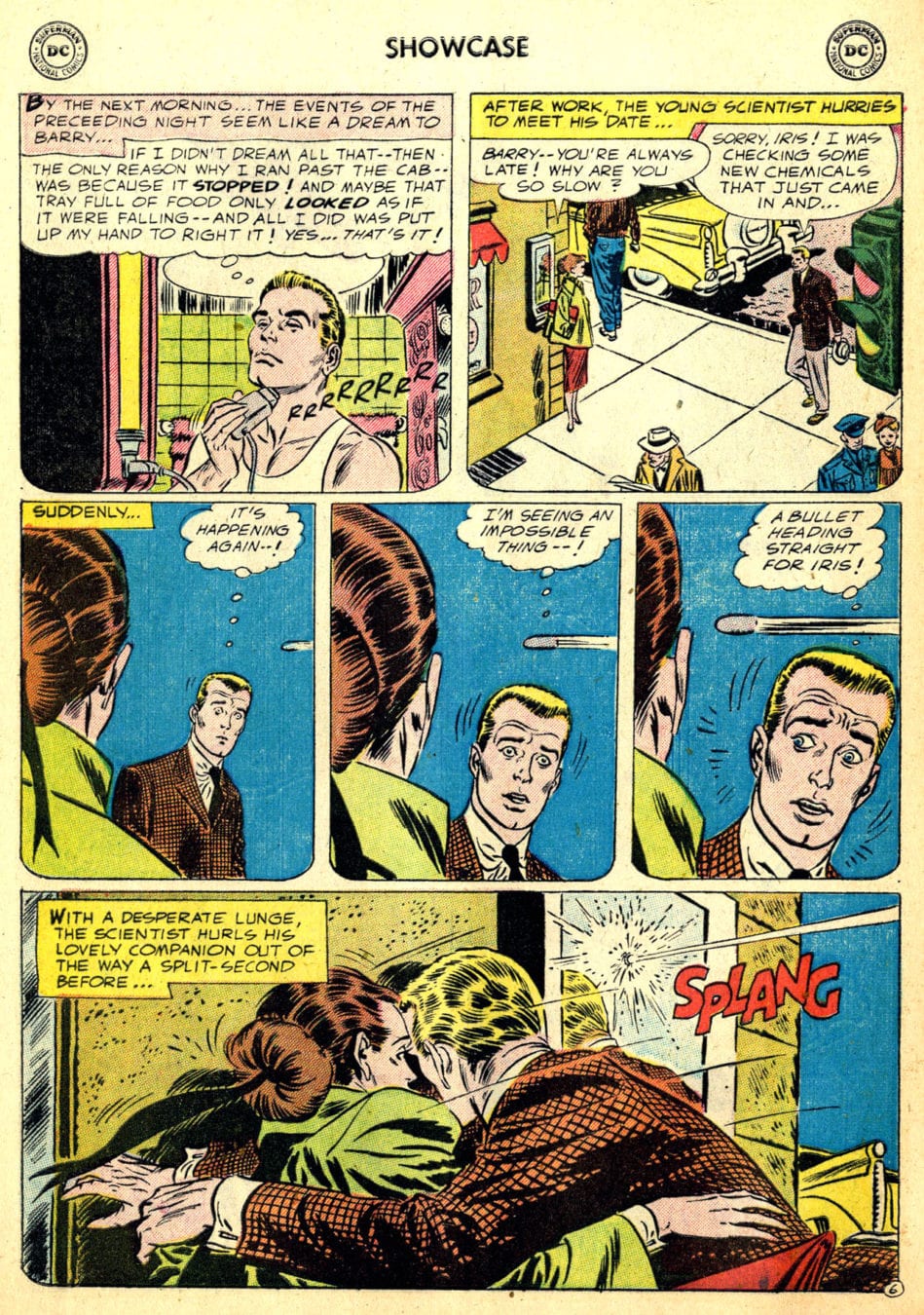 We the readers would see Iris time and again, while she was constantly chastising our hero in his civilian identity for being late. And she associated lateness with weak-mindedness and lack of drive and energy, while he would smile a little. And he gave us an aside, to let us know that she didn“t know who he really was, not like the readers did. And that he intended to keep it that way. While he took her beratement. And he needn“t wait long. The Flash makes his second appearance in Showcase # 8 (1957) by the same creative team (except Frank Giacoia on inks). So does Iris. This time, she is right there on the first page, and without Barry, mind you. We learn her last name and that she works for Picture News (a newspaper we assume), and her thoughts are on her work ever so briefly at first, and then turn to Barry: “I phoned him to meet me here for our date! He should have been here fifteen minutes ago!”“ We then see Barry in his civilian identity, helping a little girl recover a lost ring for a full page. When Barry does show up to meet Iris, he is late, of course. And we get a stern Iris, the muscles on her made-up face tightening, as she says: “Late again! What is it this time? You stop to tie your shoelace? Barry”¦ you“re so slow”¦ next to you a turtle is a jet!”“ He doesn“t tell her about the little girl he was helping, instead he apologizes to her and promises: “I“ll be quicker next time!”“ Iris then leaves Barry on the spot to attend her reporter“s job. Barry does not seem to mind this since this frees him up to his hero thing. And Iris does not miss him it seems. Well, there is a mystery and he is a scientist, but why involve him? Iris does return later to the spot she had left him. Unbeknownst to her (not the reader, mind you) he has spent the previous four pages to apprehend a masked criminal as The Flash. We cannot see Iris“ face that clearly when she eventually returns from the site she“s been to as a reporter, since now she“s presented as a small figure mid-panel, with Barry taking up half of panel“s foreground, both of them on opposite sites. Iris“ speech bubble even gets more space than her whole figure does, with her asking (demanding perhaps) “Please get me a container of coffee, and a sandwich”¦ and Barry, honey, try to get back this year?”“ And Barry? He goes into action as The Flash again, no further thought on Iris or her requests. He does return again. Twice. To the same spot. Each time having encountered the villain of the story and solving the mystery, Iris the reporter is so desperate to uncover. He returns each time without Iris realizing he even left. And each time without the coffee and sandwich she asked for. Then we see them arm in arm with Iris telling him that now he can take her out for dinner. Iris makes no appearance in the next story that introduces us to Captain Cold, one of The Flash“s main villains for years to come. Iris does return in the next issue that would feature The Flash (Showcase #13, 1958). This time, she“s present in both stories. We see her and Barry together on a date, right on the first page. Once again, her mind is on The Flash, “The world“s fastest human”“, without Barry revealing his secret to her, of course. And right in the third panel we see Iris how we got to know her by now:
We the readers would see Iris time and again, while she was constantly chastising our hero in his civilian identity for being late. And she associated lateness with weak-mindedness and lack of drive and energy, while he would smile a little. And he gave us an aside, to let us know that she didn“t know who he really was, not like the readers did. And that he intended to keep it that way. While he took her beratement. And he needn“t wait long. The Flash makes his second appearance in Showcase # 8 (1957) by the same creative team (except Frank Giacoia on inks). So does Iris. This time, she is right there on the first page, and without Barry, mind you. We learn her last name and that she works for Picture News (a newspaper we assume), and her thoughts are on her work ever so briefly at first, and then turn to Barry: “I phoned him to meet me here for our date! He should have been here fifteen minutes ago!”“ We then see Barry in his civilian identity, helping a little girl recover a lost ring for a full page. When Barry does show up to meet Iris, he is late, of course. And we get a stern Iris, the muscles on her made-up face tightening, as she says: “Late again! What is it this time? You stop to tie your shoelace? Barry”¦ you“re so slow”¦ next to you a turtle is a jet!”“ He doesn“t tell her about the little girl he was helping, instead he apologizes to her and promises: “I“ll be quicker next time!”“ Iris then leaves Barry on the spot to attend her reporter“s job. Barry does not seem to mind this since this frees him up to his hero thing. And Iris does not miss him it seems. Well, there is a mystery and he is a scientist, but why involve him? Iris does return later to the spot she had left him. Unbeknownst to her (not the reader, mind you) he has spent the previous four pages to apprehend a masked criminal as The Flash. We cannot see Iris“ face that clearly when she eventually returns from the site she“s been to as a reporter, since now she“s presented as a small figure mid-panel, with Barry taking up half of panel“s foreground, both of them on opposite sites. Iris“ speech bubble even gets more space than her whole figure does, with her asking (demanding perhaps) “Please get me a container of coffee, and a sandwich”¦ and Barry, honey, try to get back this year?”“ And Barry? He goes into action as The Flash again, no further thought on Iris or her requests. He does return again. Twice. To the same spot. Each time having encountered the villain of the story and solving the mystery, Iris the reporter is so desperate to uncover. He returns each time without Iris realizing he even left. And each time without the coffee and sandwich she asked for. Then we see them arm in arm with Iris telling him that now he can take her out for dinner. Iris makes no appearance in the next story that introduces us to Captain Cold, one of The Flash“s main villains for years to come. Iris does return in the next issue that would feature The Flash (Showcase #13, 1958). This time, she“s present in both stories. We see her and Barry together on a date, right on the first page. Once again, her mind is on The Flash, “The world“s fastest human”“, without Barry revealing his secret to her, of course. And right in the third panel we see Iris how we got to know her by now: 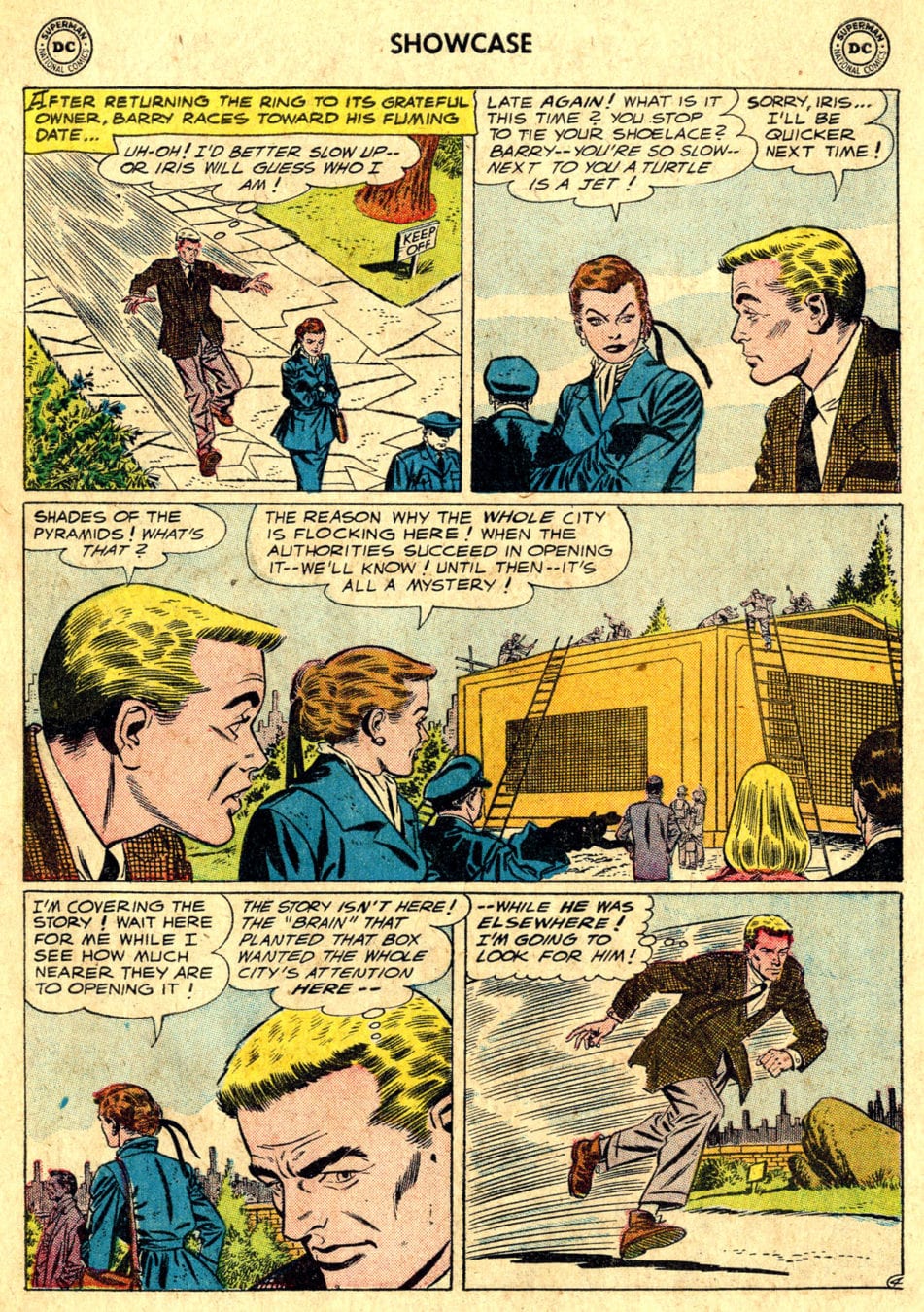 “Meanwhile, Mister Barry Allen, even if you are an absent-minded scientist, try to move faster than a turtle”¦ and meet me on time tomorrow!”“ The joke then, by the end of the story, having travelled around the world in 80 minutes as The Flash on the next day, he is on time to meet Iris by accident, because without him realizing this, he has crossed the international date line. Anyhow, him being on time makes Iris happy, for a panel. Which is completely forgotten once the next story starts. When we meet them again, we are allowed to read the couple“s thoughts: “There is Barry”¦ late again! He“s the slowest thing on two feet!”“, with Barry thinking: “I“m late, but I can“t put on a burst of speed now, or Iris would guess I“m The Flash!”“ Then, after the couple happens to hear a police report about a robbery in progress, Iris quickly declares: “I“ve got to get over there and cover it for my paper! Come on, Barry! For once in your life… hurry up!”“ There is a harsh look to her face as she stares at her date who is depicted in a profile shot, looking mild-mannered. As she rushes off, just her lower legs and feet are shown in the next panel, while Barry, his head now lowered, is left behind in the background. Iris and Barry are reunited in the last two panels of the story. While she muses about her story in the paper (“I sure wish I knew how The Flash handled an amazing villain like that.”“), she once again doesn“t miss an opportunity to throw shade at Barry, who is first seen standing at her side with his arms folded: “Of course, a stick-in-the-mud like you wouldn“t know anything about that”“, to which he responds with a smirking grin behind her back in the next panel. We the readers, are in on the joke. What may seem a bit playful at times, the thing that“s going on between these two, becomes less funny as time goes on. Right in the very next issue, Iris is back at it again: “Barry Allen! You move so slowly”¦ I doubt whether you“d win a race with a turtle!”“ While they are having lunch at a nice restaurant (Iris needs to mention how hard it is to get a reservation and that she did manage, of course), we are privy to her thoughts: “I wonder why I put up with your slowness, Barry”¦”“, with her leaving Barry right after lunch to get on an assignment for her newspaper. Without giving him a parting glance, she is instead checking her makeup in a mirror, facing the reader. When she and The Flash meet, Iris tells the Sultan of Speed: “I“d like you to meet a friend of mine”¦ Barry Allen! He“s”¦ but slower than a turtle with lumbago.”“ A friend? Huh?
“Meanwhile, Mister Barry Allen, even if you are an absent-minded scientist, try to move faster than a turtle”¦ and meet me on time tomorrow!”“ The joke then, by the end of the story, having travelled around the world in 80 minutes as The Flash on the next day, he is on time to meet Iris by accident, because without him realizing this, he has crossed the international date line. Anyhow, him being on time makes Iris happy, for a panel. Which is completely forgotten once the next story starts. When we meet them again, we are allowed to read the couple“s thoughts: “There is Barry”¦ late again! He“s the slowest thing on two feet!”“, with Barry thinking: “I“m late, but I can“t put on a burst of speed now, or Iris would guess I“m The Flash!”“ Then, after the couple happens to hear a police report about a robbery in progress, Iris quickly declares: “I“ve got to get over there and cover it for my paper! Come on, Barry! For once in your life… hurry up!”“ There is a harsh look to her face as she stares at her date who is depicted in a profile shot, looking mild-mannered. As she rushes off, just her lower legs and feet are shown in the next panel, while Barry, his head now lowered, is left behind in the background. Iris and Barry are reunited in the last two panels of the story. While she muses about her story in the paper (“I sure wish I knew how The Flash handled an amazing villain like that.”“), she once again doesn“t miss an opportunity to throw shade at Barry, who is first seen standing at her side with his arms folded: “Of course, a stick-in-the-mud like you wouldn“t know anything about that”“, to which he responds with a smirking grin behind her back in the next panel. We the readers, are in on the joke. What may seem a bit playful at times, the thing that“s going on between these two, becomes less funny as time goes on. Right in the very next issue, Iris is back at it again: “Barry Allen! You move so slowly”¦ I doubt whether you“d win a race with a turtle!”“ While they are having lunch at a nice restaurant (Iris needs to mention how hard it is to get a reservation and that she did manage, of course), we are privy to her thoughts: “I wonder why I put up with your slowness, Barry”¦”“, with her leaving Barry right after lunch to get on an assignment for her newspaper. Without giving him a parting glance, she is instead checking her makeup in a mirror, facing the reader. When she and The Flash meet, Iris tells the Sultan of Speed: “I“d like you to meet a friend of mine”¦ Barry Allen! He“s”¦ but slower than a turtle with lumbago.”“ A friend? Huh?
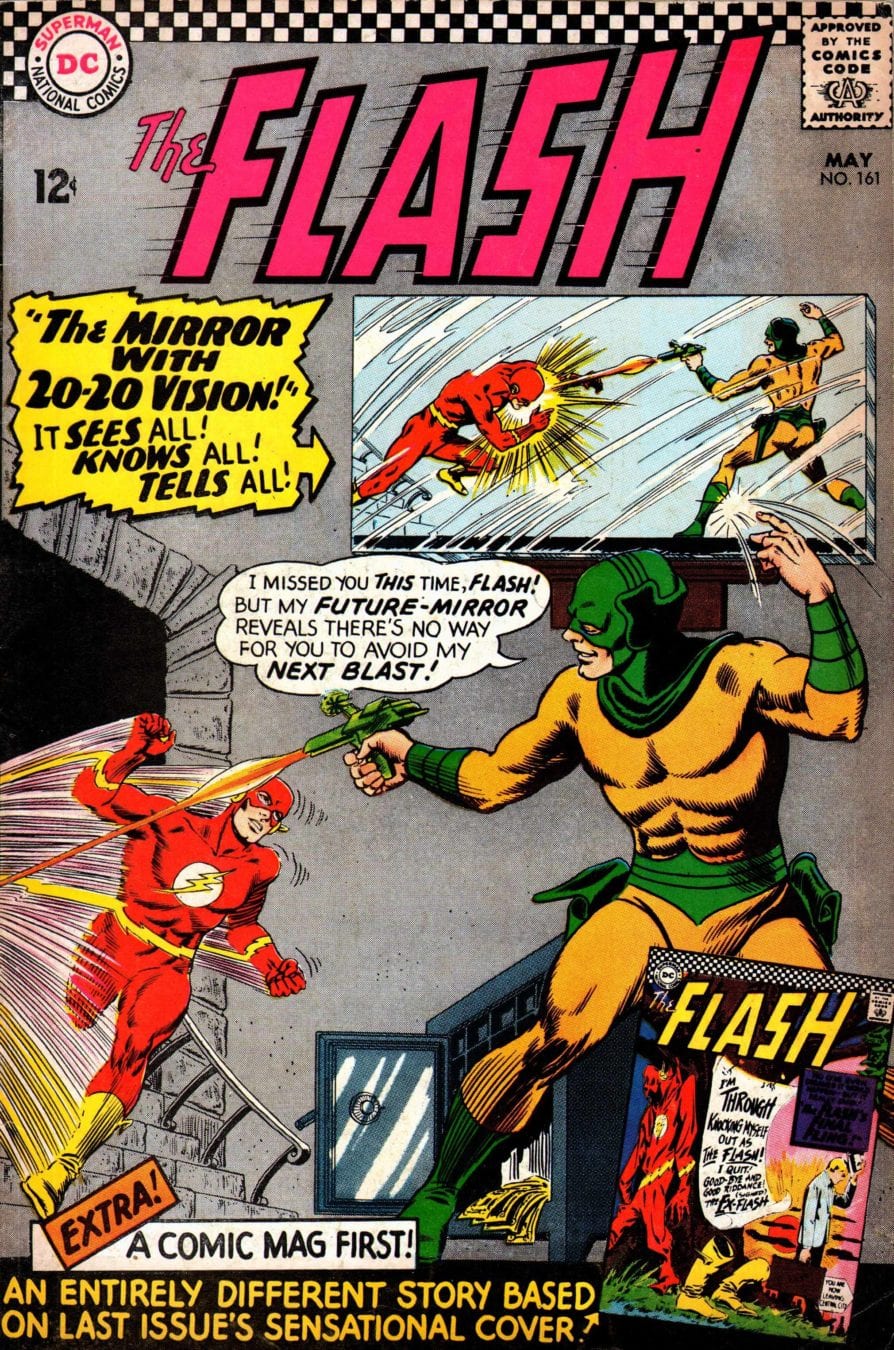 So who were these two to each other at this point in the series? In The Flash No. 106 (1959) we get this: “For weeks, Iris West”¦ my fiancée”¦ has been complaining how slow I am”¦ and that I am always late for our dates”¦!”“, which is the first time that we hear about their engagement, but in The Flash No. 109, when Barry is late once again and Iris has left him a Dear John letter, she is referred to as his “girlfriend”“ once again by the narrator, who is writer John Broome in both cases. And in issue No. 111 and No. 113, we get two stories of Iris seeing another guy, even though the couple had just made up. And to make it even worse, in the latter story, as The Flash, Barry is seen spying on Iris and her beau, one of Barry“s old college buddies no less. This was something he would do again after he and Iris got married, when Iris, on assignment for her paper, met a handsome tennis pro (The Flash No. 200, 1970). Almost as a direct response to this albeit soon forgotten rival to their relationship, we quickly get two stories about Barry“s former girlfriend Daphne, with Iris taking it up a notch once again. Iris enrolls Barry in a motivation class: “Now Barry Allen, there“s nothing wrong with you except that you“re slow”¦ and lazy”¦ and ambitionless! Don“t you ever want to be somebody”¦?”“ (The Flash No. 136, 1963). Unlike a lot of things in DC in this era, this was not forgotten, but was brought up again ten issues later. In the meantime, Iris became less and less patient it seems. And so did Barry. “Don“t you feel ashamed sometimes to be so slow-moving and lazy when The Flash”¦,”“ she starts after he has taken her for a “moonlight drive”“, only with him not letting her finish her sentence: “Gosh, Iris”¦ we can“t all be The Flash!”“, by which Barry once again lets the reader know, that he is a cool cat indeed, and that Iris cannot be trusted with his secret. (The Flash No. 140, 1963). But in the same issue, just two issues before she once again told him that he should be ashamed of himself, we see the couple kiss for the first time, and in public no less. This however releases an alien being Barry had captured as The Flash earlier. And it is their “emotional spark”“ specifically, that does this. None of that spark can be seen a few issues later when Iris does not care that Barry has taken ill, what matters to her is that he cannot serve as her date for the evening (The Flash No. 144, 1964). More so, she is oblivious to the fact that this is not the real Barry, but an imposter while she asks herself: “If this is the way Barry“s going to treat me as his fiancée, what will life be like as his wife?”“ And consequently, Barry“s changed attitude towards her is on full display in The Flash No. 154 (1965) when, in a restaurant no less, he does not take her work as a reporter seriously, and even makes fun of her ideas very publicly.
So who were these two to each other at this point in the series? In The Flash No. 106 (1959) we get this: “For weeks, Iris West”¦ my fiancée”¦ has been complaining how slow I am”¦ and that I am always late for our dates”¦!”“, which is the first time that we hear about their engagement, but in The Flash No. 109, when Barry is late once again and Iris has left him a Dear John letter, she is referred to as his “girlfriend”“ once again by the narrator, who is writer John Broome in both cases. And in issue No. 111 and No. 113, we get two stories of Iris seeing another guy, even though the couple had just made up. And to make it even worse, in the latter story, as The Flash, Barry is seen spying on Iris and her beau, one of Barry“s old college buddies no less. This was something he would do again after he and Iris got married, when Iris, on assignment for her paper, met a handsome tennis pro (The Flash No. 200, 1970). Almost as a direct response to this albeit soon forgotten rival to their relationship, we quickly get two stories about Barry“s former girlfriend Daphne, with Iris taking it up a notch once again. Iris enrolls Barry in a motivation class: “Now Barry Allen, there“s nothing wrong with you except that you“re slow”¦ and lazy”¦ and ambitionless! Don“t you ever want to be somebody”¦?”“ (The Flash No. 136, 1963). Unlike a lot of things in DC in this era, this was not forgotten, but was brought up again ten issues later. In the meantime, Iris became less and less patient it seems. And so did Barry. “Don“t you feel ashamed sometimes to be so slow-moving and lazy when The Flash”¦,”“ she starts after he has taken her for a “moonlight drive”“, only with him not letting her finish her sentence: “Gosh, Iris”¦ we can“t all be The Flash!”“, by which Barry once again lets the reader know, that he is a cool cat indeed, and that Iris cannot be trusted with his secret. (The Flash No. 140, 1963). But in the same issue, just two issues before she once again told him that he should be ashamed of himself, we see the couple kiss for the first time, and in public no less. This however releases an alien being Barry had captured as The Flash earlier. And it is their “emotional spark”“ specifically, that does this. None of that spark can be seen a few issues later when Iris does not care that Barry has taken ill, what matters to her is that he cannot serve as her date for the evening (The Flash No. 144, 1964). More so, she is oblivious to the fact that this is not the real Barry, but an imposter while she asks herself: “If this is the way Barry“s going to treat me as his fiancée, what will life be like as his wife?”“ And consequently, Barry“s changed attitude towards her is on full display in The Flash No. 154 (1965) when, in a restaurant no less, he does not take her work as a reporter seriously, and even makes fun of her ideas very publicly.
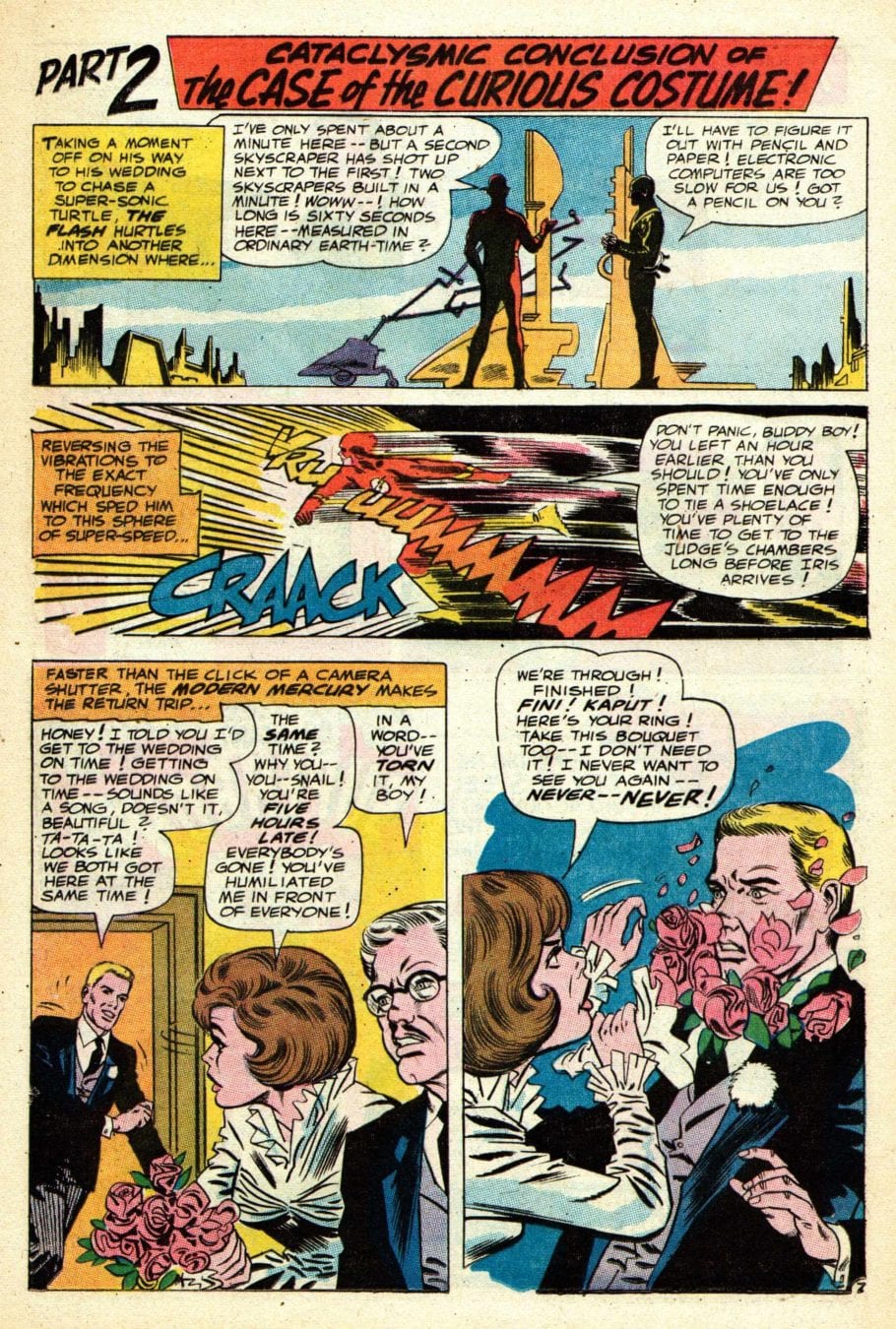 Reviewing the course their relationship had taken, it must have come as utter shock to Flash fans what they saw in The Flash No. 161 (1966). In the first panel on page four to this story (written once again by Robert Kanigher, not series regular writer Gardner Fox), we discover Iris in a wedding dress, surrounded by her family. Not only this, but the caption to the panel confirmed what seemed hard to believe and what came completely unannounced (by the characters themselves and the publisher): “The great day finally arrives for lovely Iris West, Barry Allen“s fiancée.”“ Unsurprisingly, Iris and her wedding guests and even the judge on hand to perform the ceremony, don“t talk about what happiness this will bring to her life. Everybody is concerned with Barry showing up on time. This is also what“s on in Barry“s mind: “My bachelor“s dream sure kicked up a storm last time I was late! Iris swore that if I were again this would be the very end!”“ Interestingly, we see that by this point, at least as far as time is concerned, Barry and Iris“ thinking is in perfect synchronicity. She had told him that the wedding ceremony would start a full hour earlier than it was supposed to, while he allotted an extra hour for himself to get to her. Naturally Barry got distracted on his way to the judge“s chambers. What caught his eye, was a mystery unlike any he had encountered before. Being compare to a turtle by Iris every time he showed up late once again, when, on his way to his wedding, he saw a turtle that moved faster than any car, he had to investigate. And in his is mind, he began to repeat words she“d spoken to him like a mantra. Compared to this turtle, speeding cars seemed “stuck like raisins in molasses”“, with the turtle making “jets look like sticks in the mud!”“ How strange! As The Flash, Barry discovered that the turtle was from another dimension in which time behaved so very differently. Even there, this particular turtle was the slowest creature as its owner explained: “My turtle is the slowest thing in this world! He has an inferiority complex here! He gets rid of it whenever he visits Earth and races everything there!”“ His curiosity satisfied, Barry returned home quickly. Since he had “only spent time enough to tie a shoelace”“ in the other dimension, in which time seemed to move so much slower, and with the extra hour he“d given himself, The Flash was confident that he would make it to his wedding with plenty of time of time to spare. Very pleased with himself he exclaimed: “I told you I“d get to the wedding on time!”“ He was so self-absorbed that he failed to realize, that no, he wasn“t on time. Iris and her father were staring at him angrily. Of course, he was late. Again!
Reviewing the course their relationship had taken, it must have come as utter shock to Flash fans what they saw in The Flash No. 161 (1966). In the first panel on page four to this story (written once again by Robert Kanigher, not series regular writer Gardner Fox), we discover Iris in a wedding dress, surrounded by her family. Not only this, but the caption to the panel confirmed what seemed hard to believe and what came completely unannounced (by the characters themselves and the publisher): “The great day finally arrives for lovely Iris West, Barry Allen“s fiancée.”“ Unsurprisingly, Iris and her wedding guests and even the judge on hand to perform the ceremony, don“t talk about what happiness this will bring to her life. Everybody is concerned with Barry showing up on time. This is also what“s on in Barry“s mind: “My bachelor“s dream sure kicked up a storm last time I was late! Iris swore that if I were again this would be the very end!”“ Interestingly, we see that by this point, at least as far as time is concerned, Barry and Iris“ thinking is in perfect synchronicity. She had told him that the wedding ceremony would start a full hour earlier than it was supposed to, while he allotted an extra hour for himself to get to her. Naturally Barry got distracted on his way to the judge“s chambers. What caught his eye, was a mystery unlike any he had encountered before. Being compare to a turtle by Iris every time he showed up late once again, when, on his way to his wedding, he saw a turtle that moved faster than any car, he had to investigate. And in his is mind, he began to repeat words she“d spoken to him like a mantra. Compared to this turtle, speeding cars seemed “stuck like raisins in molasses”“, with the turtle making “jets look like sticks in the mud!”“ How strange! As The Flash, Barry discovered that the turtle was from another dimension in which time behaved so very differently. Even there, this particular turtle was the slowest creature as its owner explained: “My turtle is the slowest thing in this world! He has an inferiority complex here! He gets rid of it whenever he visits Earth and races everything there!”“ His curiosity satisfied, Barry returned home quickly. Since he had “only spent time enough to tie a shoelace”“ in the other dimension, in which time seemed to move so much slower, and with the extra hour he“d given himself, The Flash was confident that he would make it to his wedding with plenty of time of time to spare. Very pleased with himself he exclaimed: “I told you I“d get to the wedding on time!”“ He was so self-absorbed that he failed to realize, that no, he wasn“t on time. Iris and her father were staring at him angrily. Of course, he was late. Again!
Time had passed him by while he had spent so little of it in the other dimension. Iris broke up with him. Later, when contemplating the situation, Barry did not spend any thought on Iris, but envisioned his life as bachelor, a life that seemed unbearable to him. The culprit for his trouble with time was discovered easily. His identity as a superhero was at fault, symbolized by his sleek red unifom. And in what predates the iconic cover to The Amazing Spider-Man No. 50 by more than a year, he throws away his costume! In an ironic twist, when Iris sees Barry putting on the costume later, after a failed attempt to win back her love as plain Barry Allen, she believes he was willing to risk his life for her with this second attempt while tangling with some crooks. Iris is convinced Barry was putting on a show just for her. Of course, she welcomes him back with open arms. Theirs was a complicated relationship. They got married only four issues later. But why would they? Find out next Wednesday when we will return to Barry and Iris!
Author Profile
- A comic book reader since 1972. When he is not reading or writing about the books he loves or is listening to The Twilight Sad, you can find Chris at his consulting company in Germany... drinking damn good coffee. Also a proud member of the ICC (International Comics Collective) Podcast with Al Mega and Dave Elliott.
Latest entries
 ColumnsDecember 30, 2020“FORGET THE NIGHT AHEAD” – WITHOUT FEAR, PART 1
ColumnsDecember 30, 2020“FORGET THE NIGHT AHEAD” – WITHOUT FEAR, PART 1 ColumnsDecember 16, 2020“I WANT TO BELIEVE” – THE CHILDREN OF THE NIGHT, PART 5
ColumnsDecember 16, 2020“I WANT TO BELIEVE” – THE CHILDREN OF THE NIGHT, PART 5 ColumnsNovember 25, 2020“HE STILL INSISTS HE SEES THE GHOSTS“ THE CHILDREN OF THE NIGHT, PART 4
ColumnsNovember 25, 2020“HE STILL INSISTS HE SEES THE GHOSTS“ THE CHILDREN OF THE NIGHT, PART 4 ColumnsNovember 11, 2020“WHATEVER WALKED THERE, WALKED ALONE” THE CHILDREN OF THE NIGHT, PART 3
ColumnsNovember 11, 2020“WHATEVER WALKED THERE, WALKED ALONE” THE CHILDREN OF THE NIGHT, PART 3







